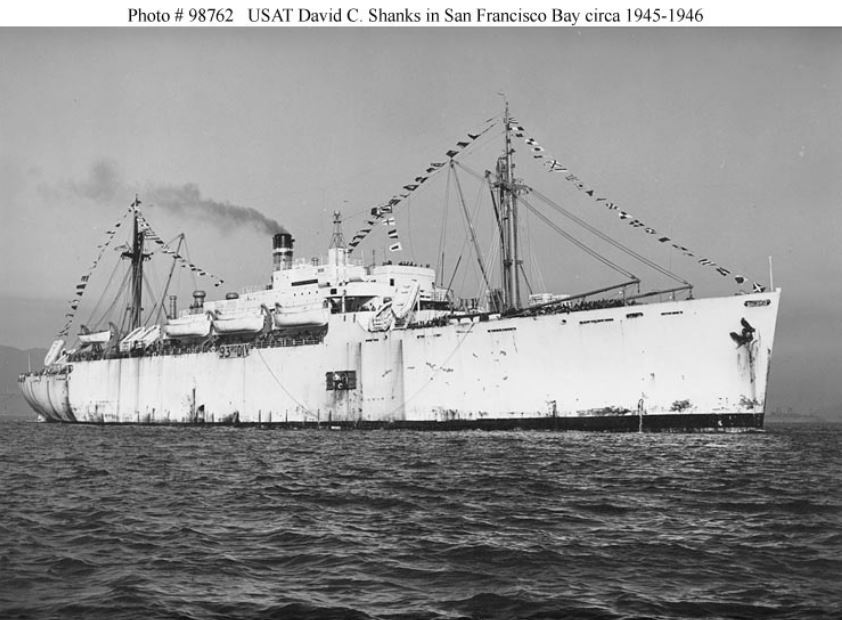USAT David C. Shanks
From Our Contribution
 In San Francisco Bay, circa early 1946. | |
| File:.jpg | |
| History | |
|---|---|
| Name | USAT David C. Shanks |
| Owner | Maritime Commission |
| Builder | Ingalls Shipbuilding |
| Yard number | 298 |
| Launched | 1943 |
| Completed | April 1943 |
| In service | May 1943 |
| Out of service | 1959 |
| Fate | scrapped |
| General characteristics | |
| Type | Troop ship |
| Tonnage | 10,418 tons |
| Length | 489 ft (149.05m) |
| Beam | 69 ft 6 in (21.18m) |
| Depth | 27 ft 4 in (8.33m) |
| Propulsion | Single screw |
| Speed | 16.5 knots (30.56 km/h) |
| Capacity | 1,935 in Army configuration |
Remarks
Ordered in 1940 by the Maritime Commission to its C3-IN P&C design as American Farmer, a combination passenger cargo liner for the United States Lines. She was requisitioned as a troopship in 1941 by the Maritime Commission, purchased by the Army, launched in 1942 at Pascagoula, Mississippi as Gulfport, and delivered to the Army in April 1943 as David C. Shanks. To offset the weight added during the troopship conversion, the outer casing of her funnel was not fitted, leaving only an ugly eight-foot diameter "smokestalk"or "midgetstack".
USAT David C. Shanks arrived at San Francisco, California in June 1943 and during the rest of the war supported Army forces in the Southwest Pacific and in the Pacific islands. In July 1945 she departed San Francisco for a brief tour in the Atlantic. Leaving Norfolk, Virginia in December 1945, she returned to San Francisco in February 1946 carrying troops from the Philippines. David C. Shanks then underwent a one-month conversion to a combination troop and dependent carrier. Between August 1947 and May 1948 she underwent a much more extensive refurbishment for peacetime service, which included restoration of her funnel casing and the cutting of over 200 portholes.
Along with most other large Army transports, the ship was transferred to the Navy's Military Sea Transportation Service in March 1950, becoming USNS David C. Shanks (T-AP-180). In 1951 she shifted her homeport from Seattle, Washington to San Francisco and for the remainder of her career transported personnel between that city's Fort Mason and locations throughout the Pacific basin. Her most frequent ports of call were Honolulu, Manila, Guam, and Kwajalein; she also made voyages to Alaska, Japan, and Taiwan. David C. Shanks completed her last voyage in Los Angeles in September 1959, moved to San Francisco in October 1959, and was deactivated and laid up in the reserve fleet at Suisun Bay, California. The ship was permanently transferred to the Maritime Administration in November 1960 and was stricken from the Naval Vessel Register in July 1961. She was sold in June 1973 for scrapping in Taiwan.